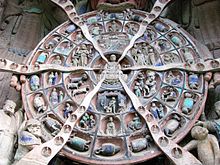
Back অনিত্য (বৌদ্ধধর্ম) Bengali/Bangla Aničča Czech Anicca Danish Anicca German Anikka Esperanto Püsitus Estonian نپایندگی Persian Anicca Finnish Anitya French Mulandóság Hungarian
| Part of a series on |
| Buddhism |
|---|
 |
| Translations of Impermanence | |
|---|---|
| English | Impermanence |
| Sanskrit | अनित्य (IAST: anitya) |
| Pali | अनिच्च (anicca) |
| Burmese | အနိစ္စ (MLCTS: anicca) |
| Chinese | 無常 (Pinyin: wúcháng) |
| Japanese | 無常 (Rōmaji: mujō) |
| Khmer | អនិច្ចំ (UNGEGN: ânĭchchâm) |
| Korean | 무상 (RR: musang) |
| Tibetan | མི་རྟག་པ་ (Wylie: mi rtag pa, THL: mi tak pa) |
| Tagalog | anissa |
| Thai | อนิจจัง (RTGS: anitchang) |
| Vietnamese | vô thường |
| Glossary of Buddhism | |

Impermanence, called anicca (Pāli) or anitya (Sanskrit), appears extensively in the Pali Canon[1] as one of the essential doctrines of Buddhism.[1][2][3] The doctrine asserts that all of conditioned existence, without exception, is "transient, evanescent, inconstant".[1]
Anicca is one of the three marks of existence—the other two are dukkha (suffering or unsatisfactory) and anatta (without a lasting essence).
Anicca is in contrast to nirvana, the reality that is nicca, or knows no change, decay or death.[1]
- ^ a b c d Thomas William Rhys Davids; William Stede (1921). Pali-English Dictionary. Motilal Banarsidass. pp. 355, Article on Nicca. ISBN 978-81-208-1144-7.
- ^ Richard Gombrich (2006). Theravada Buddhism. Routledge. p. 47. ISBN 978-1-134-90352-8., Quote: "All phenomenal existence [in Buddhism] is said to have three interlocking characteristics: impermanence, suffering and lack of soul or essence."
- ^ Robert E. Buswell Jr.; Donald S. Lopez Jr. (2013). The Princeton Dictionary of Buddhism. Princeton University Press. pp. 42–43, 47, 581. ISBN 978-1-4008-4805-8.